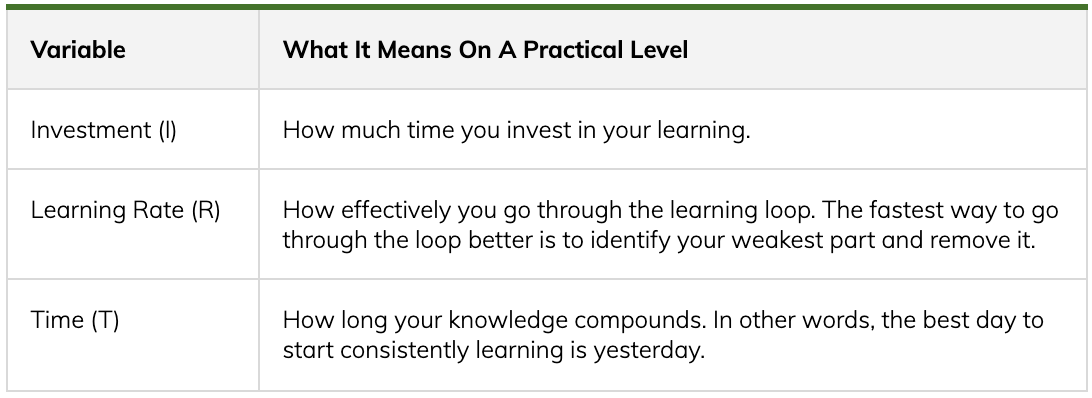Research Reveals The №1 Life Skill That Schools Surprisingly Don’t Teach
Author’s Note: This article was written over 60 hours with love and care using the blockbuster mental model. It was also originally published on Medium where it had 2,600+ likes.
In order to keep up with the world of 2050, you will need not merely to invent new ideas and products but above all to reinvent yourself again and again.
—Yuval Noah Harari
The most important skill anybody can learn is the ability to learn rare and useful skills on demand.
The reasons are simple:
To succeed over our entire career, we’ll need to learn dozens of new skills.
The most in-demand and high-paying skills of the future have not yet been created, because the world is so rapidly changing.
Therefore, it is impossible to fully front-load our learning at the beginning of our career.
The people who learn hard, in-demand skills first will have the most successful careers.
All these points are tautological—understandable by logic alone.
When I graduated in 2004, smartphones did not exist and social media hadn’t spread yet. Now, I publish all of my articles on social media and most people read them on smartphones.
Now, take someone graduating today. Let’s assume they have a 50-year career that lasts until 2070. First, by 2070, the pace of life will be 32x what it is right now. If we assume that Moore’s Law will continue, which it very likely will, the changes will be profound. Even the most maverick futurist Ray Kurzweil, Director Of Engineering at Google, doesn’t even try to predict past the 2040s. Here are just a few of his predictions of what will happen by then:
Mind uploading perfected.
Nanomachines in peoples’ brains, augmenting their cognition, senses, and giving them the ability to communicate “telepathically,” perfected.
Human intelligence multiplied by billions.
People spend most of their time in VR.
Non-biological intelligence becomes billions of times more capable than biological intelligence.
$1,000 buys a computer a billion times more intelligent than every human combined.
Or, let’s just take the next 10 years rather than the next 50. We are currently amidst some of the biggest changes in human history all happening at once:
Given the changes on the horizon, you would think that learning how to learn would be taught in every school and baked into the corporate culture of every company. It isn’t.
In fact, the opposite is true. Not only is learning how to learn not taught, but our popular culture is filled with dangerous learning myths that sabotage people’s success and cause them to waste countless hours learning mediocre skills they don’t remember for more than a few weeks and never apply.
In this article, I will dispel the five biggest learning myths and share a research-backed, universal model of learning you can use for the rest of your life.
Let’s jump in…
The 5 Learning Myths That Are Sabotaging Your Career
Over my life, I’ve read thousands of books and applied my lessons to build successful companies (and several failed companies). If there is a learning mistake, I’ve made it. I’ve now spent years reading academic research on learning, experimenting with the principles in my life, and incorporating them into a curriculum that has reached thousands and into the largest learning how to learn community in the world (340,000+ members).
Here are the big five learning myths I see most often:
These five myths beg the question, what is the most effective way to learn?
Fortunately, there is an answer that has been proven over and over across time and across the fields of psychology, warfare, artificial intelligence, business, and the learning sciences…
The Origin Of A Universal Learning Model
In the era of 1950s air warfare, there was a peculiar anomaly. In dog fights between MiG-15s and F-86s, the plane that was expected to win (the MiG-15) constantly lost. To explore this, Colonel John Boyd (one of the best Air Force pilots in history) decided to research and get to the root of the situation.
The question was, how could an inferior aircraft win so decisively?
Boyd had a theory:
Boyd decided that the primary determinant to winning dogfights was observing, orienting, planning, and acting faster. In other words, how quickly one could iterate. Speed of iteration, Boyd suggested, beats quality of iteration.
The next question Boyd asked is this: why would the F-86 iterate faster? The reason, he concluded, was something that nobody had thought was particularly important. It was the fact that the F-86 had a hydraulic flight stick whereas the MiG-15 had a manual flight stick.
Without hydraulics, it took slightly more physical energy to move the MiG-15 flight stick than it did the F-85 flight stick. Even though the MiG-15 would turn faster (or climb higher) once the stick was moved, the amount of energy it took to move the stick was greater for the MiG-15 pilot.
With each iteration, the MiG-15 pilot grew a little more fatigued than the F-86 pilot. And as he got more fatigued, it took just a little bit longer to complete his OODA loop. The MiG-15 pilot didn’t lose because he got outfought. He lost because he got out-OODAed.
These insights lead us to Boyd’s Law of Iteration: the speed of iteration beats the quality of iteration.
So what does iteration mean in this context? It means how quickly you go through Boyd’s OODA loop.
In the aerial dogfight, the loop looks like this…
Observe the other aircraft.
Orient yourself by analyzing the situation.
Decide what to do.
Act (steer or fire).
The underlying model of the OODA Loop also applies in a much broader context…
Introducing The Universal Learning Loop
I first heard about the OODA Loop in 2005. The next time I thought about it was when I had a thought leader agency, and one of my clients was a world-renowned expert in artificial intelligence. He helped me see that AI followed the same exact sort of loop…
Sensors or programs collect data.
Algorithms analyze that data after it is stored on the internet.
Then, there is experimentation in the world to test the ideas.
Feedback from the experiment is used to improve.
In other words, the loop is:
Data
Algorithms
Experimentation
Feedback
Immediately, I saw the connection with our own intelligence as animals and humans…
We collect data about the world through our five senses.
Our brain, which is made up of biological algorithms, makes sense of the data so we can make decisions.
We move around in the world and try things out.
We use the feedback to do better next time.
I also saw it in academia. I interviewed Berkeley-trained researcher Theo Dawson and learned about her Virtuous Cycle of Learning model. Also, Harvard researcher David Kolb’s model of experiential learning has the same logic. And, I also learned about it when studying epistemology and the scientific method…
There are three principal means of acquiring knowledge: observation of nature, reflection, and experimentation. Observation collects facts; reflection combines them; experimentation verifies the result of that combination.
—Philosopher Denis Diderot
Finally, I saw it in business with Eric Reis’ Build-Measure-Learn Loop.
In other words, across warfare, AI, learning sciences, business, philosophy, and animal intelligence, there is almost the same exact loop. I call this the Learning Loop mental model, and it is the fundamental learning process of the universe. It’s a durable model of learning that will last you the rest of your life.
Each step builds on the next in a compounding loop.
Information. Taking in information via people, info, and experiences.
Algorithms. Processing that information unconsciously and via reflective questions. And then taking notes.
Experimentation. Taking action on the reflections to identify and move forward on the highest leverage actions without procrastination.
Feedback. Identifying key variables and rapidly seeing the impact of your experiments on those variables.
By applying the Learning Loop to your life, you can dramatically increase your success in two ways…
#1. Compound Your Learning Like Warren Buffett
The following passage from the only authorized biography of Warren Buffett drives home the power of compound knowledge…
If you are investing in your education and you are learning, you should do that as early as you possibly can, because then it will have time to compound over the longest period. And that the things you do learn and invest in should be knowledge that is cumulative, so that the knowledge builds on itself. So instead of learning something that might become obsolete tomorrow, like some particular type of software [that no one even uses two years later], choose things that will make you smarter in 10 or 20 years.
The reason compounding is so powerful is because, as time goes by, the interest from your past investments does most of the work for you. We’ve all heard the story about how if you just put $100 per week into your bank account starting at age 20 you’ll be a millionaire by the time you retire. The same applies to learning. Follow the 5-Hour Rule for your entire career, and you will be a mental millionaire.
This chart is essentially why Albert Einstein reportedly referred to compound interest as the eighth wonder of the world.
On a practical level, compounding your learning means using a modified version of the compound interest formula…
The beauty of this simple formula is that it gives you three leverage points (the three variables) to improve your learning. In this way, I think of The Learning Loop as the E=MC2 of learning.
Other approaches to “accelerated learning” are often based on passing a test. With these approaches, the focus is often on speed reading and memorization. The Learning Loop, on the other hand, is the best model for improving your success and impact in the real world.
Finally, whereas compounding happens over a long period of time, the learning loop is immediately helpful. It helps you…









